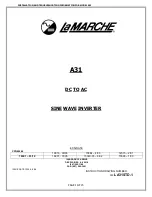
INSTALLATION AND TROUBLESHOOTING INFORMATION FOR MODEL A31
PAGE 2 OF 15
1.
SAVE THESE INSTRUCTIONS
. This manual contains important safety and operating instructions. Before
using this equipment, read all instructions and cautionary markings on (1) unit, (2) battery, and (3) product
using the battery.
2.
CAUTION:
To reduce risk of injury and/or damage to the batteries, use only the type of batteries specified on
the charger nameplate.
3.
Do not expose equipment to rain or snow.
4.
Do not operate equipment if it has received a sharp blow, been dropped, or otherwise damaged in any way;
take it to a qualified serviceman.
5.
Do not disassemble this unit; take it to a qualified serviceman when service or repair is required. Incorrect re-
assembly may result in a risk of electric shock or fire.
6.
To reduce risk of electric shock, disconnect this unit from the AC supply, batteries and loads before attempting
any maintenance or cleaning. Turning off controls will not reduce this risk.
7.
WARNING
– RISK OF EXPLOSIVE GASES
a.
Working in the vicinity of a battery is dangerous. Some batteries generate explosive gases during normal battery
operation. For this reason, it is of utmost importance that each time before using this unit, you read this manual and
follow the instructions
b.
To reduce risk of battery explosion, follow these instructions and those published by the battery manufacturer and
manufacturer of any equipment you intend to use in the vicinity of the battery. Review cautionary marking on all
products.
8.
PERSONAL PRECAUTIONS:
a.
Someone should be within range of your voice or close enough to come to your aid when you work near a battery.
b.
Have plenty of fresh water and soap nearby in case the battery electrolyte contacts skin, clothing, or eyes.
c.
Wear complete eye protection and clothing protection. Avoid touching eyes while working near a battery.
d.
If the battery electrolyte contacts skin or clothing, wash immediately with soap and water. If the electrolyte enters the
eye, immediately flood the eye with running cold water for at least ten (10) minutes and get medical attention
immediately.
e.
Never smoke or allow a spark or flame in vicinity of a battery.
f.
Be extra cautious, DO NOT drop metal onto a battery. It might spark or short-circuit the battery or cause an explosion.
g.
Remove personal metal items such as rings, bracelets, necklaces, and watches when working with a battery. A battery
can produce a short-circuit current high enough to weld these items causing severe burns.
h.
NEVER charge a frozen battery.
i.
Do not use battery charger for charging dry-cell batteries that are commonly used with home appliances. These batteries
may burst and cause injury to person or damage to property.
9.
PREPARING TO CHARGE
a.
If it is necessary to remove the battery connections, always remove grounded terminal from the battery first. Make sure
all loads are disconnected and unit is off, so as not to cause an arc.
b.
Be sure the area around the battery is well ventilated while the battery is being charged.
c.
When cleaning battery terminals, be careful to keep corrosion from coming in contact with eyes.
d.
Study all the battery manufacturer’s specific precautions such as removing or not removing cell caps while charging,
recommended rates of charge, and maintenance procedures.
e.
Follow the battery manufacturer's recharging instructions.
10.
UNIT LOCATION
a.
Never place this unit directly above the standard flooded battery. Gases from the battery will corrode and damage
equipment. A sealed maintenance free or valve regulated lead acid (VRLA) may be placed below this equipment.
b.
Never allow the battery electrolyte to drip on this unit when reading the specific gravity or filling the battery.
c.
Do not operate this unit in a closed-in area or restrict ventilation in any way.
d.
Do not set any battery on top of this unit.
11.
D.C. CONNECTION PRECAUTIONS
Connect and disconnect DC output cables only after setting all of this unit's switches to off position and removing AC
input supply. Do not pull on output cables when disconnecting charger from battery.
12.
GROUNDING INSTRUCTIONS
This battery charger should be connected to a grounded, metal, permanent wiring system; or an equipment
grounding conductor should be run with circuit conductors and connected to equipment-grounding terminal or lead
on battery charger. Connections to battery should comply with all local codes and ordinances.
IMPORTANT SAFETY INSTRUCTIONS

































